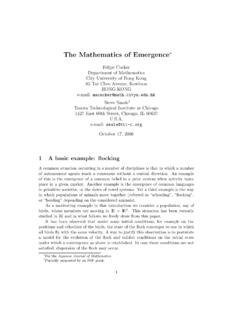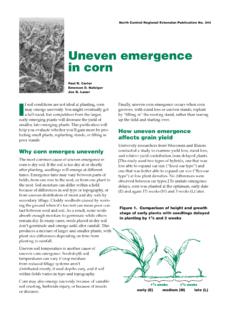Transcription of Silk Development and Emergence in Corn - Purdue University
1 7/12/16, 7:49 AMSilk Development and Emergence in corn - Corny News Network ( Purdue University )Page 1 of 5 University Department of AgronomyCorny News NetworkJuly 2016 URL: Development and Emergence in (Bob) NielsenAgronomy Dept., Purdue Lafayette, IN 47907-2054 Email address: rnielsen at corn produces individual male and female flowers on the same ear represents the female flower of the corn soil moisture deficits can delay silk Emergence and disrupt the synchrony of pollen shedand silk availability, resulting in poor kernel corn plant produces individual male and female flowers (a flowering habit calledmonoecious for you corny trivia fans.)
2 Interestingly, both flowers are initially bisexual (aka perfect ), but during the course of Development the female components (gynoecia) of the maleflowers and the male components (stamens) of the female flowers abort, resulting in tassel (male)and ear (female) silks that emerge from the ear shoot are the functional stigmas of the female flowers of a cornplant. Each silk connects to an individual ovule (potential kernel). A given silk must be pollinated inorder for the ovule to be fertilized and develop into a kernel. Up to 1000 ovules typically form per ear,even though we typically harvest only 400 to 600 actual kernels per , growth stage R1 (Abendroth et al.)
3 , 2011) for a given ear is defined when a single silkstrand is visible from the tip of the husk. A field is defined as being at growth stage R1 when silkshave emerged on at least 50 % of the plants. This whole field definition for growth stage R1 issynonymous with the term "mid- silk ". silk Elongation and EmergenceSilks begin to elongate from the ovules 10 to 14 days prior to growth stage R1 or approximately at theV12 leaf stage. silk elongation begins first from the basal ovules of the cob, then proceedssequentially up the ear. Because of this acropetal sequence of silk elongation, silks from the basal(butt) portion of the ear typically emerge first from the husk, while the tip silks generally emerge silk Emergence from an ear generally occurs within four to eight days after the first silksemerge from the husk silks first emerge from the husk, they lengthen as much as inches per day for the first day ortwo, but gradually slow over the next several days.
4 silk elongation occurs by expansion of existing7/12/16, 7:49 AMSilk Development and Emergence in corn - Corny News Network ( Purdue University )Page 2 of 5 , so elongation rate slows as more and more cells reach maximum size. Elongation of anindividual silk stops shortly after pollen is captured, germinates and then penetrates the not pollinated, silk elongation stops about 10 days after silk Emergence due to senescence of thesilk tissue. Unusually long silks can be a diagnostic symptom that the ear was not remain receptive to pollen grain germination up to 10 days after silk Emergence , but to an ever-decreasing degree.
5 The majority of successful ovule fertilization occurs during the first 4 to 5 daysafter silk Emergence (see photos that follow).Natural senescence of silk tissue over time results in collapsed tissue that restricts continued growthof the pollen tube. silk Emergence usually occurs in close synchrony with pollen shed, so thatduration of silk receptivity is normally not a concern. Failure of silks to emerge in the first place,however, does not bode well for successful and FertilizationFor those of you serious about semantics, let's review two definitions relevant to sex in the is the act of transferring the pollen grains to the silks by wind or insects.
6 Fertilization is theunion of the male gametes from the pollen with the female gametes from the ovule. Technically,pollination is almost always successful ( , the pollen reaches the silks), but unsuccessful fertilization( , pollen tube failure, silk failure, pollen death) will fail to result in a grain germination occurs within minutes after a pollen grain lands on a receptive silk . A pollentube, containing the male genetic material, develops and grows inside the silk , and fertilizes the ovulewithin 24 hours. Pollen grains can land and germinate anywhere along the length of an exposedreceptive silk . Many pollen grains may germinate on a receptive silk , but typically only one willsuccessfully fertilize the Emergence FailureSevere Drought Stress.
7 The most common cause of incomplete silk Emergence is severe droughtstress. Silks have the greatest water content of any corn plant tissue and thus are most sensitive tomoisture levels in the plant. Severe moisture deficits will slow silk elongation, causing a delay orfailure of silks to emerge from the ear shoot. If the delay is long enough, pollen shed may be almostor completely finished before receptive silks are available; resulting in nearly blank or totally blankcobs. Severe drought stress accompanied by low relative humidity can also desiccate exposed silksand render them non-receptive to pollen severity of drought stress required for significant silk Emergence delay or desiccation canprobably be characterized by severe leaf rolling that begins early in the morning and continues intothe early evening hours.
8 Such severe leaf rolling is often accompanied by a change in leaf color from healthy green to a grayish-tinged green that may eventually die and bleach to a straw Clipping by Insects. Although technically not described as silk Emergence failure, severe silkclipping by insects such as corn rootworm beetle or Japanese beetle nonetheless can interfere with7/12/16, 7:49 AMSilk Development and Emergence in corn - Corny News Network ( Purdue University )Page 3 of 5 elongation on the lower half of a V12ear shoot; 10 to 14 days before elongation on the lower 2/3 of a V14ear, about 4 days after V12; 6 to 10 daysbefore silk silk length along length of cob atfirst silk Emergence ; illustrating theacropetal Development of recently clipped with a knife.
9 Note thediscolored, non-receptive ends of the silkswhere the clipping success of pollination by decreasing or eliminating viable or receptive exposed silk , unless the beetle activity is nonstop for days, continued elongation of silks from the huskwill expose undamaged and receptive silk tissue at the rate of about one inch or more per "Balling". Occasionally, silks fail to emerge successfully because they fail to elongate in theirusual straight "path" up the ear toward the end of the husk leaves. Instead, silk elongation becomesconvoluted (twisted, coiled, scrambled) inside the husk leaves. This silk "balling" phenomenon is notwell-understood and hybrids tend to vary in their vulnerability to this type of silk Emergence different pieces of circumstantial evidence are often associated with the problem.
10 One is aphysical restriction imposed on silk elongation caused by unusually"tight" or long husk leaves incertain hybrids. The other circumstance often correlated with silk "balling" is the occurrence ofunusually cool nights during the time silk elongation is occurring, but prior to silk Emergence . Thephysiological effect of such cool nights on silk elongation is not understood. It has been years since Ilast saw a field with a significant level of silk "balling" (Nielsen, 2000).Click on image to view larger , 7:49 AMSilk Development and Emergence in corn - Corny News Network ( Purdue University )Page 4 of 5 inches of silk elongation sincebeing manually clipped about corn Rootworm beetles(Diabrotica spp.)











